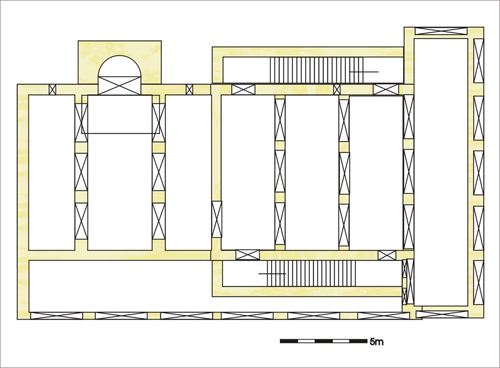![]() Robert B. J. Mason
Robert B. J. Mason
Near and Middle-Eastern Civilizations (NMC)
University of Toronto
|
Near and Middle-Eastern Civilizations (NMC) |
|
University of Toronto - Near and Middle Eastern Civilizations - Mason Home - Unnofficial Mason - Royal Ontario Museum |
|
A Museum for Deir Mar Musa al-Habashi Planning a new museum to house the finds, and an interpretive centre
The proposed museum and interpretive centre for the monastery of St. Moses the Abyssinian is conceived in three phases, although if sufficient funding were found it would be possible it would be possible to build it all in one go! The building will be constructed of local materials (stone) using traditional techniques and local labour. The first phase would be to build the ground floor of the main exhibition building, comprising a main hall of about 10 by 10 metres, with the portico over the southern elevation of the building. This could function immediatly as a museum, housing the main entrance, reception and ticket sales, a gift shop, and a small cafe, together with the ground floor exhibition space. Exhibits for this space would be the archaeology of the region, including finds from the restoration of the monastery buildings, and the archaeological survey and excavation of the caves in the area. While the archaeological team were operating, the building would also function as the logistical base, with space for accommodation and processing the finds and other results of fieldwork. It is estimated that it would cost approxiamtely $20,000 Canadian dollars to construct this building The second phase of construction would be to create a second story for the main exhibition building. This would house exhibits on the natural history and biodiversity of the wadi Mar Musa, the valley in which the monastery is situated. This area is presently proposed to become a National Park, and an important point will be with current efforts to reverse the trend of desertification in the region. The portico on the south elevation, and also that on the west elevation planned in the third phase of construction, would be a terrace for this exhibition space, where visitors could go out and view the valley itself. It is estimated that construction of this phase would cost an additional $10,000 Canadian dollars.
The third phase of construction would involve reconstructing the church of the monastery on the other side of the main exhibition buildings.
Apart from the building itself, it is proposed to recreate the final phase of the frescoes of the church.
This will allow a full didactic interpetation of these important works of art, as well as providing a vivid idea of what they would have looked like
after their completion in 1192 AD. There will also be exhibits on the iconography of the frescoes, and the restoration of the frescoes.
This part of the building will also house permanent offices and laboratory space for the staff and fieldworkers.
It is estimated that construction of this phase would cost an additional $30,000 Canadian dollars.

Museum phase 3, plan
The museum would be staffed by locals and would contribute to the local economy through increased tourism and employment. Materials for things such as the building and cases will be sourced locally. Some specialized display materials may have to come from Canada, but the hope is to use local craftsmanship and materials as far as possible. The development of the museum using local resources also offers the opportunity for the training of one or two Syrian students in the principles of museology. At the end of the project, aside from a fully curated museum, there will be a complete digital catalogue of objects in a database (Access 2003) incorporating digital images of all the objects currently stored in the museum. This database will be the basis of collection management in the museum, object labeling in the exhibit, and will provide opportunities for online international access to information about the region, as well as possibilities for marketing images. Further, the digital catalogue will ensure a clear record of ownership, following the recommendations of the UNESCO 1970 convention, which specifies the need for a national inventory of cultural objects.
Deir Mar Musa al-Habashi
|
|
|
University of Toronto - Near and Middle Eastern Civilizations - Mason Home - Unnofficial Mason - Royal Ontario Museum |